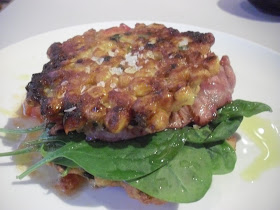I was getting anxious. The same set of dim sum trolleys had gone past our table twice yet there was still no sign of my beloved
har gau (蝦餃). Don't get me wrong, I was enjoying a post-Christmas lunch with my folks at Manchester's
Glamorous Restaurant, but the thing is dim sum isn't dim sum without these superior prawn dumplings.
A waitress walked by our table. I asked her to send the
har gau trolley our way. Her response that there was no trolley nearly sent me over the edge. Calm was only restored after she explained that
har gau had to be ordered separately, as they can get a little tired sweating away in a trolley. Not for the first time, I realised just how much I take some old favourites for granted.
 |
| Har gau 蝦餃 @ Lei Garden (Singapore) |
Har gau translated into English simply means prawn dumpling. Typically, this dumpling consists of prawns seasoned with soy, white pepper and sesame oil in a pleated wrapper made with wheat flour and tapioca flour. These are then cooked and served in a bamboo steamer, usually consisting of four dumplings in a portion.
It really goes without saying that the quality of
har gau is a benchmark of how good a restaurant is for dim sum. However, there are restaurants that sell
har gau but don't do a full dim sum service. I'd be wary of such places, as there's a high probability that the dumplings are from a packet out of the freezer. Some of these can be OK, but they're rarely as good as freshly-made
har gau.
What makes good har gau?
In my opinion, these are the things to look out for:
1) The wrapper – this must be thin enough that it's translucent yet not so delicate that it will easily break. The number of pleats is also important, the more the better (around ten shows proper skill).
2) The filling – the prawns should be coarsely chopped rather than finely minced. The filling should also retain a good 'bite' and not be mushy.
3) Bamboo shoots - good
har gau should include a few slivers of bamboo shoots for a contrast in texture and flavour. Sadly, all too many restaurants don't bother nowadays.
 |
| Steamed wasabi prawn dumplings 日式芥辣蝦餃 @ Phoenix Palace (London) |
Where's the best place for har gau?
In London, my favourite is
Phoenix Palace, where they also serve
har gau with a twist in the form of
wasabi prawn dumplings (日式芥辣蝦餃). I don't often advocate dicking around with a classic, but I love the kick from the wasabi inside the dumpling.
Outside of London, I'm afraid my list isn't as comprehensive as it should be. Like I mentioned before, I've been taking
har gau for granted for far too long. Having said that, I do remember the
har gau at
Lei Garden in Singapore being different class (see first photo).
Can I make har gau at home?
It is possible, but it takes a lot of effort. For starters, you need to get in the right kind of wheat flour and tapioca flour from a Chinese supermarket. My Mum made some over Christmas, and they were tasty but I didn't ask for a recipe (it's not as if I'm ever going to make them!). However, if you do want to try making
har gau, check out
Sunflower Food Galore's recipe.
And lastly, do shout if you know of a restaurant that serves good
har gau. It doesn't have to be in London, it can be anywhere in the world. I don't care as long as it's good!
PS: I haven't forgotten! Kung Hei Fat Choi! Gong Xi Fa Cai! 恭喜發財! I'd like to wish my readers all the very best for the Year of the Dragon!













